Regional employment patterns in Scotland: statistics from the Annual Population Survey 2017
Summary publication of results from the Annual Population Survey 2017, presenting analysis on the labour market, education and training.
This document is part of a collection
Section 3: Equality
3.1 Young people
The youth (16-24) employment rate in Scotland increased by 3.5 percentage points over the year from 55.9 per cent in 2016 to 59.4 per cent in 2017, while the UK rate increased by 0.6 percentage points from 53.5 per cent to 54.1 per cent over the same period.
The local authority areas with the highest youth (16-24) employment rates in Scotland in 2017 were Orkney Islands (88.6 per cent), Midlothian (80.2 per cent) and Na h-Eileanan Siar (73.7 per cent).
The areas with the lowest youth employment rates during this period were Glasgow City (45.2 per cent), East Dunbartonshire (50.8 per cent) and Stirling (50.9 per cent). It should be noted that youth employment rates in university cities are likely to be lower due to higher levels of economically inactive students.
Statistically significant changes over the year were seen in Aberdeen City (up 19.2 percentage points from 42.9 per cent to 62.0 per cent) and Clackmannanshire (up 33.7 percentage points from 35.3 per cent to 69.0 per cent) as well as Scotland overall. In total, 19 local authority areas saw increases in their youth employment rates over the year, with 13 seeing decreases.
Figure 3: Employment Rate 2017 16-24 year olds (per cent)
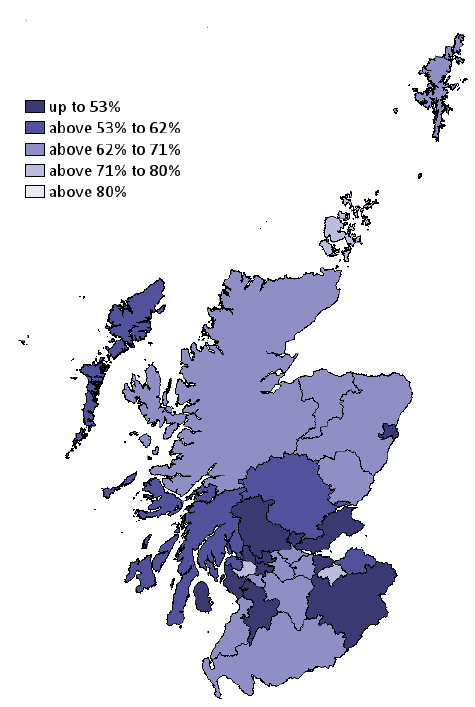
3.2 NEET
8.5 per cent of people aged 16-19 years were not in employment, education or training ( NEET) in 2017, a decrease of 2.2 percentage points* from 2016 and a decrease of 4.7 percentage points* from the peak in 2010 (13.2 per cent).
The percentage of 16-19 year olds who are not in employment, education or training has typically been higher for males than female and in 2017, the NEET rate for men was 9.5 per cent compared with 7.4 per cent for women.
The 16-19 year olds who are not in employment, education or training has typically been higher for 18-19 year olds compared with 16-17 year olds.
* statistically significant
Chart 18: Percentage of 16-19 year olds who are not in employment, education or training since 2004 by gender, Scotland
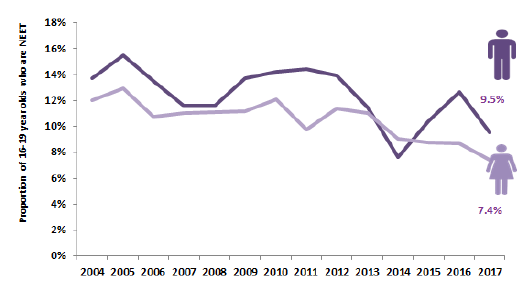
Chart 19: Percentage of 16-19 year olds who are not in employment, education or training since 2004 by age, Scotland
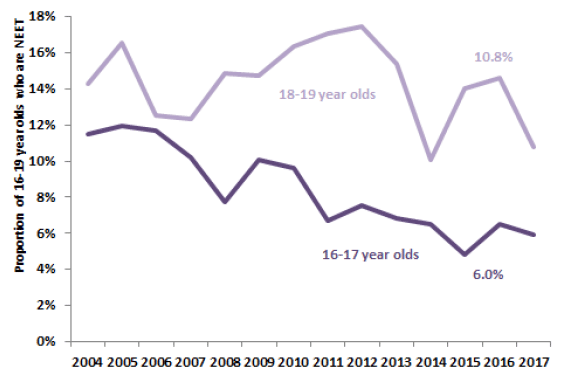
3.3 Older Workers
Figure 4: Employment Rate 2017 50 year olds and over (per cent)
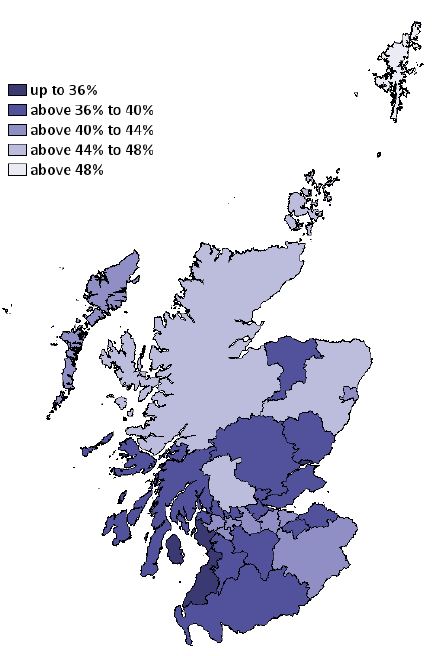
84,700 people aged 65 years and over were in employment in Scotland in 2017, almost twice as many as ten years ago.
The employment rate for those aged 65 years and over increased from 5.7 per cent in 2007 to 8.5 per cent in 2017.
The employment level for those aged 50 to 64 years increased by 138,000 from 624,000 in 2007 to 762,000 in 2017. The employment rate increased from 64.4 per cent in 2007 to 69.6 per cent in 2017. Men accounted for one third of the increase, whilst women account for two thirds.
The local authorities with the highest employment rate for those aged 50 years and over were; Shetland Islands (50.3 per cent), Orkney Islands (46.9 per cent) and Highland (46.1 per cent).
The most common reason for working past the age of 65 years was being ‘Not ready to stop working’ reported by 55.8 per cent.
Chart 20: Reasons for working for those aged 65 years and over in Employment
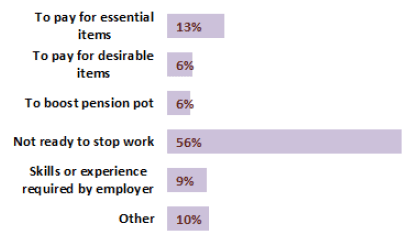
3.4 Disability
In 2017, the employment rate for those classed as disabled under the Equality Act 2010 was 45.4 per cent which is lower than the employment rate for those not classed as disabled (81.2 per cent). In 2017 the employment rate gap was 35.8 percentage points.*
The gap between the employment rate for disabled and non-disabled people has decreased by 1.6 percentage points over the year. The employment rate for disabled people increased by 2.6 percentage points from 42.8 per cent in 2016 to 45.4 per cent in 2017*, while the employment rate for non-disabled people increased by 1.0 percentage point from 80.2 to 81.2 per cent.
The gap between in the employment rate for disabled and non-disabled people was lower for women (31.6 percentage points) than men (40.2 percentage points).
* statistically significant
Chart 21: Employment rate (16-64) for disabled and not disabled by gender
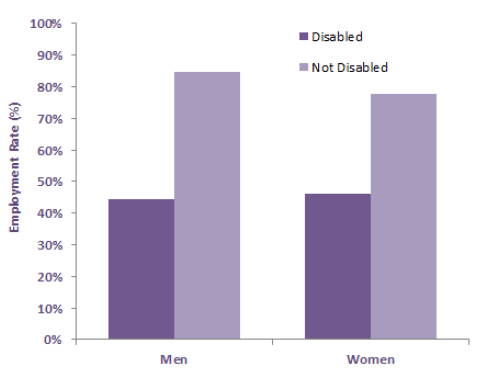
Data on disability
ONS
advise that comparisons should be made with caution due to an
apparent discontinuity in data following Apr-Jun 2017 and
inconclusive investigations on the source for this.
The disability employment gap is calculated as the
non-disabled employment rate – disabled employment
rate.
Chart 22: Employment rate (16-64) by disability and age 2017, Scotland
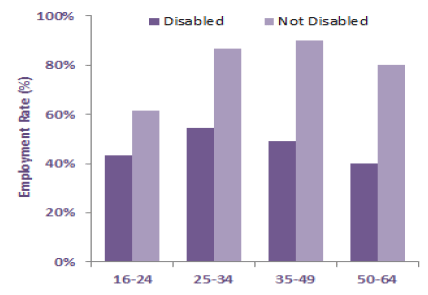
The employment rate gap between the employment rate for disabled and non-disabled people was lower for young people (18.5 percentage points) and increased with age and was highest for those age 35-49 years (41.0 percentage points).
There is regional variation in the employment rate for those who reported a disability. 25 per cent of all disabled people in employment reside in Glasgow City (14.2 per cent) and Edinburgh (10.3 per cent).
Data on disability
ONS
advise that comparisons should be made with caution due to an
apparent discontinuity in data following Apr-Jun 2017 and
inconclusive investigations on the source for this.
Chart 23: Employment rate (16-64) for disabled people by local authority: 2014, 2017
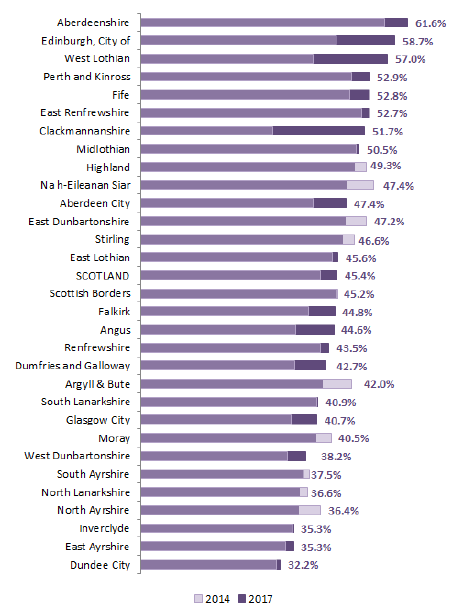
Notes: Employment rate labels displayed for 2017
3.5 Ethnicity
The employment rate for the minority ethnic population aged 16-64 was 60.6 per cent which is lower than the white population with an employment rate of 75.0 per cent giving a gap in employment rate between minority ethnic and white aged 16 to 64 years of 14.4 percentage points.
The white population has, over time, consistently had an employment rate which exceeds the minority ethnic population.
The minority ethnic employment gap was much higher for women than men; for women the minority ethnic employment gap was 22.8 percentage points and for men was 5.7 percentage points.
Chart 24: Employment rate (16-64) for minority ethnic and white population, Scotland
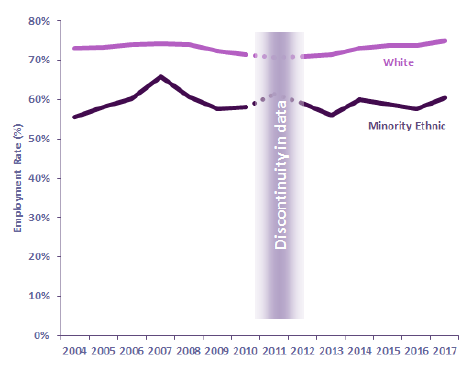
The employment rate for the minority ethnic population was highest in Ayrshire (77.1 per cent) and West Scotland (73.3 per cent).
The gap in the employment rate for the minority ethnic population was largest for the 16-24 year old population. The gap decreases with age with the oldest age group (50-64 years) having higher employment rates for the minority ethnic group than in the white ethnic group.
Chart 25: Employment rate (16-64) for minority ethnic and white people by gender
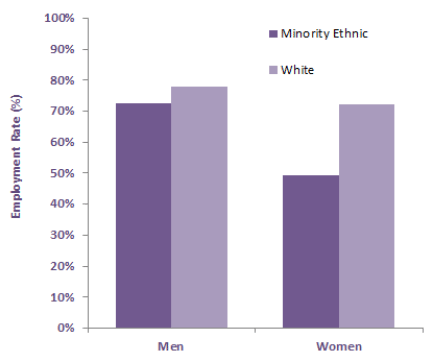
Contact
If you have any enquiries relating to Labour Market Statistics then please contact us at:
Email: LMStats@gov.scot
Telephone: 0131 244 6773
Fax: 0300 244 1060
Post:
Labour Market Statistics
OCEAES: Economic Strategy and Policy
Scottish Government
5th Floor
5 Atlantic Quay
150 Broomielaw
Glasgow
G2 8LU
We welcome any comments on both the format and content of the website, including any problems you may encounter.
You may also contact the Statistician Group Enquiries for general information.
There is a problem
Thanks for your feedback